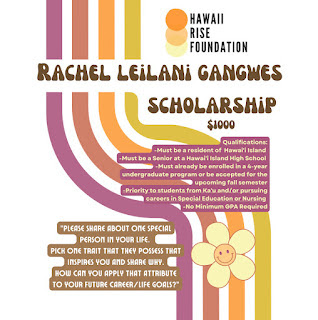.jpg) |
| Darlyne Vierra, of Kaʻū Multicultural Society, with her display on Saturday at the Prince Kuhio Day Ho'olaulea in Nāʻālehu. Photo by Julia Neal |
KAʻŪ MULTICULTURAL SOCIETY SEEKS A PERMANENT HOME. The Hawaiian collection of Kaʻū Multicultural Society's archives of photos, publications and items celebrating the history of Kaʻū were on display Saturday at the Prince Kuhio Day Ho`olaulea in Nāʻālehu. Founders Darlyne Vierra and Liz Kuluwaimaka were on site, interpreting their collection. The organization provides its displays for many community events focusing on themes of each gathering, from the anniversary of the Portuguese coming here to Paniolo, the Hawaiian cowboys and local ranches, to the heritage in Hawai'i Volcanoes National Park. On Saturday, the focus was Hawaiian.
Kaʻū Multicultural Society also sponsors an annual pig hunt, with the hunters themselves representing the vast ethnic diversity of the community. The organization is searching for a building in Kaʻū where it can house its permanent display, open to the public and host community events about Kaʻū's history and the multicultural essence of this place.
Contact Darlyne Vierra at 808-640-8740, dvierrra22@gmail.com, and Liz Kuluwaimaka at 808-339-0269. Vierra said Kaʻū Multicultural Society is a registered non-profit organization.
.jpg) |
| Dr. Tara Schoenwetter and Ada Pulin at the Kaʻū Multicultural Society display at Prince Kuhio Day Ho'olaulea. Photo by Julia Neal |
The earthquake happened at 6:39 p.m., 32 miles southeast of Nāʻālehu and 4.8 miles deep, according to the USGS Hawaiian Volcano Observatory report.
Some Waiohinu area residents reported a strong shaking, with other reports from Volcano and along the Puna Coast and further inland. In Pāhala, the ground was quiet.
The seamount, an underwater volcano, is called Kamaʻehuakanaloa and Lō‘ihi. The Pacific Tsunami Warning Center reported no threat of tsunami.
Magnitude 3.1 and 3.2 quakes occurred earlier in the day.
 |
| Keiki are invited to the Pohakuloa U.S. Army Garrison open house on April 20 to learn about careers, volunteer work and the military mission at the training base off Saddle Road. Photo from Pohakuloa |
POHAKULOA, THE U.S. ARMY GARRISON TRAINING AREA, has announced its annual open house for the public on April 20 from 9 a.m. to 1 p.m.to learn about its mission, community partnerships and STEM activities for school-aged youth. The free event organizers aim to promote goodwill and positive community relations between the public and the military battlefield training area.
Participating organizations include the U.S. Army showing aircrafts and equipment; and its U.S. Army Band, with recruiters on hand; U.S. Army Corps of Engineers; U.S. Marine Corps with its aircrafts and equipment; Hawai'i National Guard Youth Challenge Academy; Hilo Veterans Center; Hawai'i Army National Guard Soldier & Family Readiness Office; and the state's Department of Land & Natural Resources Napu'u Readiness & Environment Protection Integration Program.
Also showcasing their missions will be: American Red Cross; Camp Tarawa Foundation; Hawai'i Wildfire Management Organization & Waikoloa Firewise; Ho'ilina Ranch; Honoka'a Heritage Center;
Mauna Kea Observatories; and Wounded Warriors.
Participating organizations include the U.S. Army showing aircrafts and equipment; and its U.S. Army Band, with recruiters on hand; U.S. Army Corps of Engineers; U.S. Marine Corps with its aircrafts and equipment; Hawai'i National Guard Youth Challenge Academy; Hilo Veterans Center; Hawai'i Army National Guard Soldier & Family Readiness Office; and the state's Department of Land & Natural Resources Napu'u Readiness & Environment Protection Integration Program.
Also showcasing their missions will be: American Red Cross; Camp Tarawa Foundation; Hawai'i Wildfire Management Organization & Waikoloa Firewise; Ho'ilina Ranch; Honoka'a Heritage Center;
Mauna Kea Observatories; and Wounded Warriors.
Food trucks and Post Exchange will be open for purchases. Be prepared to show Government-issued identification for all adults. Random vehicle may be searched for security. Organizers remind the. publid that it is 10-20 degrees cooler at PTA than in the lowlands; dress accordingly with no open-toe shoes.
Pohakuloa is located off Saddle Road, the Daniel K. Inouye Highway.
 |
| Rare plant identification, propagation and restoration make up one of the programs at Pohakuloa. Photo from Pohakuloa |
To read comments, add your own, and like this story, see facebook.com/kaucalendar. See latest print edition at kaucalendar.com, in the mail and on stands.
A ROBUST UNIFIED PLAN FOR MISSLE DEFENSE OF HAWAI'I was the message last week from Sen. Mazie Hirono, member of the U.S. Senate Armed Services Committee. She questioned General Glen VanHerck, Commander of the U.S. Northern Command (NORTHCOM) and North American Aerospace Defense Command during a full committee hearing.“General VanHerck, you are responsible for homeland defense and you noted this morning that you have concerns about attack assessment and threat warning, and that brings me to concerns I have about the missile defense of Hawai'i—concerns that I’ve been expressing for a number of years now,” said Hirono during the hearing. “And I do remain concerned that the Department of Defense does not have a plan to address the current and future missile defense needs of Hawai'i.”
A statement from Hirono's office said, "As a senior member of the Armed Services Committee, Senator Hirono is fighting to ensure the Department of Defense (DoD) is ready and able to defend Hawai'i from foreign threats, and has repeatedly pressed DoD leadership on the need for a unified, department-wide plan for the missile defense of Hawai'i. In a hearing last month, Senator Hirono pressed the Commanders of U.S. Strategic Command and U.S. Space Command about the roles their commands play in Hawaii’s missile defense." Hirono said, “There is no single Commander entirely responsible for coordinating the DOD’s defense of Hawai'i. So, just as we saw in the crisis at Red Hill, when no single leader has ultimate responsibility for the coordination and execution of the mission, there is room for issues to fall through the cracks and adding to the concerning lack of trust that Hawaii’s communities have regarding the military.”
A link to download video of Hirono’s full question line is available here. As a member of the Senate Armed Services Committee and Chair of the Armed Services Subcommittee on Readiness and Management Support, Hirono is focused on overseeing the safe closure of Red Hill, rebuilding and modernizing military infrastructure in Hawai'i and around the country, strengthening U.S. relationships with partners and allies, and advancing DOD’s work to combat climate change, said the statement from her office.
To read comments, add your own, and like this story, see facebook.com/kaucalendar. See latest print edition at kaucalendar.com, in the mail and on stands.
In the mail and on stands.

FREE FOOD
St. Jude's Hot Meals are free to those in need on Saturdays from 9 a.m. until food runs out, no later than noon. Volunteers from the community are welcome to help and can contact Karen at pooch53@gmail.com. Location is 96-8606 Paradise Circle Drive in Ocean View. Those in need can also take hot showers from 9 a.m. to noon and use the computer lab from 9:30 a.m. to 1 p.m.
Free Meals Mondays, Wednesdays, and Fridays are served from 12:30 p.m. to 3:30 p.m. at Nā'ālehu Hongwanji. Volunteers prepare the food provided by 'O Ka'ū Kākou with fresh produce from its gardens on the farm of Eva Liu, who supports the project. Other community members also make donations and approximately 150 meals are served each day.
OUTDOOR MARKETS
Volcano Evening Market, Cooper Center, Volcano Village, Thursdays, 3 p.m. to 6 p.m., with live music, artisan crafts, ono grinds, and fresh produce. See facebook.com.
Volcano Swap Meet, fourth Saturday of the month from 8 a.m. to noon. Large variety of vendors with numerous products. Tools, clothes, books, toys, local made healing extract and creams, antiques, jewelry, gemstones, crystals, food, music, plants, fruits, and vegetables. Also offered are cakes, coffee, and shave ice. Live music. Volcano Farmers Market, Cooper Center, Volcano Village on Sundays, 6 a.m. to 10 a.m., with local produce, baked goods, food to go, island beef and Ka'ū Coffee. EBT is used for Supplemental Nutrition Assistance Program, formerly Food Stamps. Call 808-967-7800.
O Ka'ū Kākou Market, Nā'ālehu, Wednesdays, 8 a.m. to 2 p.m. Contact Nadine Ebert at 808-938-5124 or June Domondon 808-938-4875. See facebook.com/OKauKakouMarket.
Ocean View Community Market, Saturdays and Wednesdays, 6:30 a.m. to 2 p.m., corner Kona Dr. Drive and Hwy 11, near Thai Grindz. Masks mandatory. 100-person limit, social distancing required. Gate unlocked for vendors at 5:30 a.m., $15 dollars, no rez needed. Parking in the upper lot. Vendors must provide their own sanitizer. Food vendor permits required. Carpooling is encouraged.
-1.jpg) |











.jpg)
.jpg)
.jpeg)


